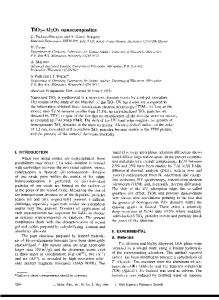Development of a hybrid metal-oxides (Li 2 O-Al 2 O 3 -Al 3 Fe-Al 3 Fe 5 O 12 ) reinforced polycaprolactone composite
- PDF / 805,204 Bytes
- 9 Pages / 432 x 648 pts Page_size
- 96 Downloads / 351 Views
MRS Advances © 2020 Materials Research Society DOI: 10.1557/adv.2020.28
Development of a hybrid metal-oxides (Li2O-Al2O3Al3Fe-Al3Fe5O12) reinforced polycaprolactone composite N.N. Zurita-Méndez1, J. Beltran-González1, G. Carbajal-De la Torre1, M.A. EspinosaMedina1,* 1 Facultad de Ingeniería Mecánica, Universidad Michoacana de San Nicolás de Hidalgo, C.P. 58000; Morelia, Michoacán, México
* Corresponding author: [email protected]
ABSTRACT
This paper addresses the chemical synthesis and characterization of a composite formed by Li2O-Al2O3-Al3Fe-Al3Fe5O12/PCL which were obtained by the process of reduction of ferric chloride (FeCl3) with lithium aluminum hydride (LiAlH4) in an open atmosphere. The goal of the development of this hybrid material was to perform a superparamagnetic material with several potential applications. The results of the characterizations by scanning electron microscopy (SEM) and vibrating sample magnetometer showed a Li 2O-Al2O3-Al3FeAl3Fe5O12 “desert rose stone”-like morphology 3D hierarchical powders formation when particles were sintered at 850 °C. Homogeneous nanometric particles after calcination at 1100 °C were observed. X-ray diffraction analysis were performed to determine their composition. Subsequently, the superparamagnetic powders were added by dispersion in a polycaprolactone (PCL) matrix, and then, were evaluated by SEM for the observation of their morphologies. The composite material presented a polymer network with an opened structure, a well dispersion of the oxides particles into the interstices with irregular topography and reliefs.
INTRODUCTION Composite materials with diverse microstructure conformations are widely used in several engineering applications; due they display a combination of the best characteristics of each one of the compositional phases, resulting in a superior material. 3485
Downloaded from https://www.cambridge.org/core. UCSD University of California San Diego, on 23 Jun 2020 at 09:30:22, subject to the Cambridge Core terms of use, available at https://www.cambridge.org/core/terms. https://doi.org/10.1557/adv.2020.28
Since the 1940 ’s the engineering-designed polymer matrix composites (PMC’s) became dominant because of the relatively good bonding between polymers and filler phases, and the low density of polymers which is important for lightweight structures [1,2]. The manipulation of microstructures is the key to control the properties of all materials, so the composites with high design possibilities are more suitable for the development of functional (or multifunctional) materials as well the smart materials, because of it is possible to regulate its symmetry and to choose their connecting forms achieving their optimal value [3]. Li2O-Al2O3 systems have been studied by several authors in different application areas, like the incorporation of Li 2O and Al2O3 in bioactive glass materials [4-6], and magnetic glass-ceramic materials based in the Li 2O-Fe2O3-Al2O3-SiO2 system [7]. In catalysis, the usage of a Fe2O3-Li2O system in ammonia oxidation
Data Loading...











